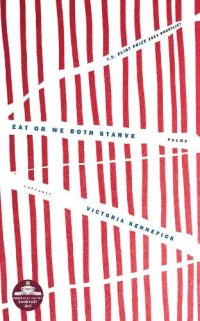Eat Or We Both Starve (Shortlisted, TS Eliot Prize 2021)
Victoria Kennefick’s latest collection, Eat Or We Both Starve, is a considered and powerful meditation on what it means to hunger and, subsequently, to consume. Kennefick weaves historical figures, literary references and personal memories into her work in a painstaking attempt to examine hunger in its myriad forms – be it physical, sexual, relational or spiritual. At times, the poems are so interconnected in theme that the entire collection feels concentrated into one sharp burst of writing. Yet it is clear that Kennefick’s process has been refined and reoriented, as many of the poems contain a wisdom and strength – the voice of an embodied womanhood.
Kennefick’s most dizzyingly erotic lines follow in the tradition of blending the sacred and profane; many of her figures read like Madame Bovary, as in ‘Hunger Strikes Catherine of Siena (1347-1380)’:
Oh, Bonaventura, I am a house of sticks,
my bones rattle with desire until I lick it.
I feel it quiver, alive on my tongue.
Like Bovary, Kennefick’s women blur the line between a yearning for the divine and an embodied lust, a dangerously female desire. Her Catholic upbringing is evidently a wellspring of inspiration for Kennefick. The poems do not seek so much to transgress as to understand the whys and hows of the shame so deeply embedded in her Catholic roots. After all, ‘eating’ exists on a spectrum with shame at the one end and the symbolic Eucharist at the other, highlighted in poems like ‘Corpus Christi Procession’ and ‘Second Communion’.
In Kennefick’s realm, everything is consumption; everything becomes a metaphor for the act of consuming and the act of consuming a metaphor for simply being human. She very subtly draws the line between what we think we ought to want, as in the instances of youth peppered throughout the collection –
In the nightclub I drank
Peach Schnapps with ice
my heart a nest of eggs(‘Big Girl’)
and wanting as a reflection of a true need. A literal example of this may be the stark ‘Researching The Irish Famine’ for obvious reasons but less literal examples are gifted repeatedly, comparing existential longing with an urge to eat meat, for instance. The form she adopts is largely contemporary, lyrical and spacious. The words themselves feel disintegrated in certain lines, as though mimicking a kind of digestion. Some poems are deliberately claustrophobic. This is perhaps to reflect her most basic point: that our hunger is never satisfied – and the fact of this overwhelmingly apparent in everything from a conversation with a friend to the devout prayer of a Saint.
Kennefick’s parents have an undeniable presence within the collection. Two poems are dedicated to her father’s illness, while her mother in particular seems to shift in the background, before emerging in poems like ‘Choke’:
that’s what I’m looking for –
that’s what I’m looking for –
my mother’s finger
down my throat,
pushing
sugar
deep into me.
It is perhaps a woman’s rite of passage to reflect upon her own mother, and herself in light of her discoveries. Indeed, Kennefick captures the simultaneous closeness and distance between mother and daughter with extraordinary insight and sensitivity. One poem sees her making up a guest bedroom, attempting to emulate her mother. Another sees her looking at her own reflection in the mirror. Again, there is a starvation. Again, there is the trouble of yearning for a bond which has changed, evolved, which is no longer assured. Kennefick brings her mother to life with half-melancholy, half-humour.
Eat Or We Both Starve is shrewd, moving and a must-read for the year ahead.
Zoe Cassells


Leave a Reply